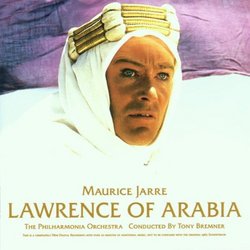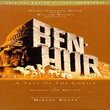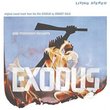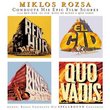| All Artists: Maurice Jarre Title: Lawrence of Arabia Members Wishing: 0 Total Copies: 0 Label: Silve Release Date: 5/19/2000 Album Type: Import Genre: Soundtracks Style: Number of Discs: 1 SwapaCD Credits: 1 |
Search - Maurice Jarre :: Lawrence of Arabia
 | Maurice Jarre Lawrence of Arabia Genre: Soundtracks
|
Larger Image |
CD DetailsSimilar CDs
|
CD ReviewsA classic Score for a classic Film! Amer K. Zahid | Karachi, PAKISTAN | 01/17/2005 (5 out of 5 stars) "LAWRENCE OF ARABIA is one of those grand sweeping and majestic scores that instantly conjure pure romanticism. It's hard to imagine the likes of such that will ever be paralleled in scope and grandeur that is Lawrence of Arabia. It is a miracle unto itself and Maurice Jarre's shimmering score is as legendary and epic on scale. The original presentation of the score exists in a rather poor sounding album available on the Varèse label and then the Cinephile Castle CI recording. The OST is also another re-recording which was made at the time of the film's original 1962 release and conducted by Jarre. Sir Adrian Bolt is credited with the actual conducting for the film version but reports exist that Jarre did conduct the majority. Sadly, the original masters were lost and destroyed in 1975. Thus, a thirst and demand existed to re-create this grand epic again. Enter label Silva records and producer James H. Fitzpatrick: Silva Records financed a new recording of this legendary Oscar Winning score (Jarre's first nomination) to be performed with The Philharmonia Orchestra. This album was released in 1989 to co-incide with restoration of the "Director's Version" by Robert A. harris and Jim Painten. For this recording, the Original Orchestrations of Gerard Schurmann were revised under the auspices of orchestrator Christopher Palmer and Maurice Jarre himself. Jarre, who was initially slated to conduct the recording (but left before his deal was finalized) wanted to improve on the scope of the score probably due to the liberties of modern sound recording. Sadly, the project proceeded without Jarre's further involvement and conductor Tony Bremner landed the job. The score was recorded at CTS Studios, Wembley in January 1989 with Dick Lewezy supervising the sound recording. Unfortunately, due to a mastering fault and some "professional" producers expertise the album got released with some rather noticeable and faulty bias towards the right hand sound channel. While, on the whole the album contained a breathtaking performance of the score and gave a new life to the music it eventually failed to inspire the required response from the fans and even Maurice Jarre was put off by it. Although, that probably had more to do with his deal not working out than the recording itself. Despite this technical error the problem was corrected and Silva recalled the faulty albums and re-pressed a new master but the first impression created a rift in the fans between those who still liked it and those who simply didn't. Last year Producer James Fitzpatrick culled the original recording sessions and proceeded to Whitfield Street Studios with engineer Mike Trevor Ross and had the whole album re-mixed and remastered for a special HDCD Dolby Surround presentation which in my opinion blows its previous incarnation to smithereens. This HDCD Dolby Surround recording sounds stout, fuller and more symphonic in nature. Dick Lewezy's superb close miking shine in this new arrangement and make for a spectacular epic sound. In fact, It comes across more close to Bruce Broughton's re-recording of Herrmann's JASON AND THE ARGONAUTS than the ones dished out by Varèse. The brilliant score contains two major themes. The first is the unabashedly romantic and sweeping theme for the Arabian desert and the other is the boyish romping March like theme for Lawrence himself. Both themes are given regal presentation especially in the thundering "Overture" and the lively "Main Titles". The rest of the score is built on these motives and modulated through out. In the midst, Jarre develops a distinct motive and a theme for the Arabs. This secondary motif introduced in the Overture is primitive and ethnic and helps to elicit a rather savage sound for the Arabs. "First Entrance of the Desert" opens beautifully with the Arabian theme performed on flute and leads with T.E. Lawrence's start of his journey. The music accompanies the breathtaking photography while at the same time capturing the romanticism and mystery of the desert. Jarre also introduces a primitive synthesizer known as a "Ondes Martenot' to capture the eerie feeling of the vastness of arabian space notably in "Night and Stars". There is also comic relief and joviality expressed in "Lawrence and Tafas". Also prominent is the source music:" The Voice of the Guns" - the British band piece for the British Army Head Quarters. The music although arranged in the film and structured within the score is actually composed by Kenneth J. Alford. There is also plenty of atmospheric cues for the treacherous and mysterious desert evident in "That is the Desert" and "The Sun's Anvil". Jarre also develops a triumphant fanfare piece which is first introduced when Lawrence rescues a local in the great desert journey in "The Rescue of Qasim". Adding color to the orchestration is the woodwind which tries to mimics a peculiar wailing sound made by Arab women during "Horse Stampede" which also displays a spectacular array of Brass and drums. All in all, this a grand and epic score beautifully recorded and finally presented in a entirely new package with some striking color pictures and featuring detailed notes by producer James Fitzpatrick discussing the origins of the film as well as containing candid discussions with the composer. This is a handsome package and worth its legend. A must for every film music enthusiast! " Something must have gone wrong Holger Lippold | Leipzig | 04/23/2009 (1 out of 5 stars) "As regards acoustic engineering, this re-recording of the famous score has failed completely. In fact, I thought the orchestra was playing under a blanket. After turning the volume almost up to the maximum, I found that the sterility of the sound can hardly be topped. This CD is a real disappointment, something must have gone wrong. I would definitely recommend to buy the original sound track from 1962. Of course it corresponds to the technical status of that time, but it provides a sonority that exceeds all expectations."
|

 Track Listings (13) - Disc #1
Track Listings (13) - Disc #1

